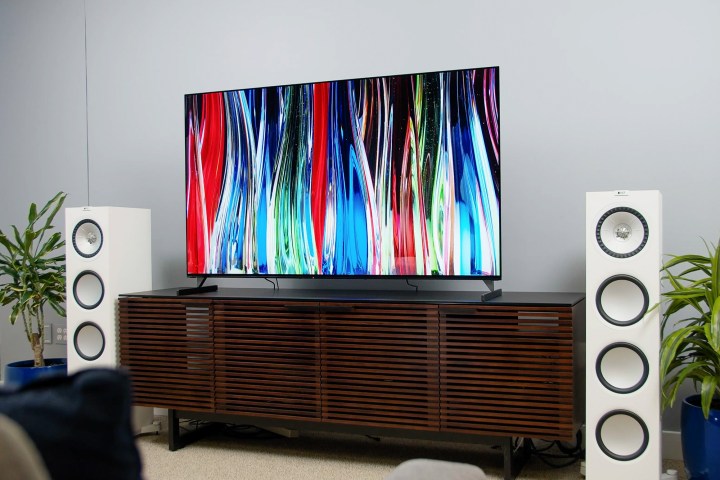Buying a new TV can be a fun-filled adventure — but also an agonizing nightmare. In stores and online, you’re bombarded with terms like HDR, OLED, QLED, 4K Ultra HD and Full HD. But what do they mean? Well, the latter two are resolutions, and they’re used to indicate the number of pixels on a screen. As far as TV lingo goes, the more pixels there are, the better the picture quality. To understand why, though, we have to look at each resolution a bit more closely. Only then can you start considering what screen size is best and finally start taking a look at our list of the best 4K TVs to find the television of your dreams.
Pixels
Pixels are the building blocks for every display you’ve ever seen. They’re tiny little dots that, together, make up the picture you see on a screen. You can only see these pixels if you’re fairly close to the screen, of course. From a proper viewing distance, thousands of them blend to make the image on your screen.

Resolutions
720p
A 720p resolution television has 1,280 columns and 720 rows of pixels, hence “720p.” Multiply the two numbers for a total of 921,600 pixels. This is the minimum TV resolution that can be called “high definition,” or HDTV.
1080p
Often, 1080p is referred to as “Full HD.” In a 1080p television, there are 1,920 columns multiplied by 1,080 rows for a total of 2,073,600 pixels — more than twice as many pixels as you’ll find in a 720p TV screen. For a while now, 1080p has been the industry standard for high-definition displays, and most content (that is, television broadcasts, shows, and movies) is produced and distributed in 1080p.
4K Ultra HD
The next level of HD is 4K — often called “Ultra HD” or UHD. Technically, the name is a bit of a misnomer because there are 3,840 columns and 2,160 rows of pixels that make up a 4K TV screen, which is why you’ll occasionally see this resolution referred to as 2160p. That’s a total of 8,294,400 pixels, which is four times as many pixels as a Full HD 1080p display and nine times as many pixels as a 720p display. This is considered a high pixel density.
For a long time, Ultra HD resolution televisions hovered on the edge of the market, too expensive for most viewers to buy (which in turn meant that creating 4K content wasn’t a worthwhile investment for studios). That has changed in the past few years, as UHD TVs have become affordable for even cost-conscious consumers, resulting in studios caving and churning out 4K material left, right, and center.
Additionally, you’ll also see several other consumer tech items boasting 4K as a top feature. This is everything from 4K home security cameras to 4K gaming monitors.


Why upgrade?
So what does all this mean? What’s the point of upgrading from your beloved CRT TV to a sparkling 65-inch UHD display? Well, first of all, it just looks better — a lot better. Lines will be sharper, curves will be smoother, and the level of detail will be far greater. With a higher-resolution screen, you can sit closer without seeing the pixels (context: you don’t want to see the pixels).
There’s also size to keep in mind. If you’re buying a 24-inch TV for your kitchen, for example, you’re barely going to notice the difference between 720p and 1080p. Similarly, if you’re buying a 32-inch TV for your bedroom, you’re not going to notice many benefits from 4K resolution. That said, with prices being so comparatively low, if you’re looking at a TV over 40 inches, you might as well opt for 4K.
Plus, manufacturers these days are fully focused on creating high-quality 4K TVs, which means they often boast improved tech, like support for high dynamic range (HDR) color.
The future
Worried that the pricey 4K television you’ve been eying will be outdated in a year or two? Don’t be — at least, not yet. They say 8K is on the way, but this resolution is insanely expensive for now. The human eye only can perceive so much detail, which means the difference between 4K and 8K isn’t as visually drastic as the difference between 1080p and 4K, so you’ll be safe for the foreseeable future.
Editors' Recommendations
- Best 70-inch TV deals: Get a big screen for sports for $420
- Walmart says Onn 4K Pro will eventually only ship with a backlit remote
- TCL prices its insanely bright, 115-inch QM89 4K TV at $27,000
- Best Buy TV deals: Save on QLED TVs, OLED TVs, and 8K TVs
- Best 85-inch TV deals: Save on Samsung, Sony, TCL, and more



